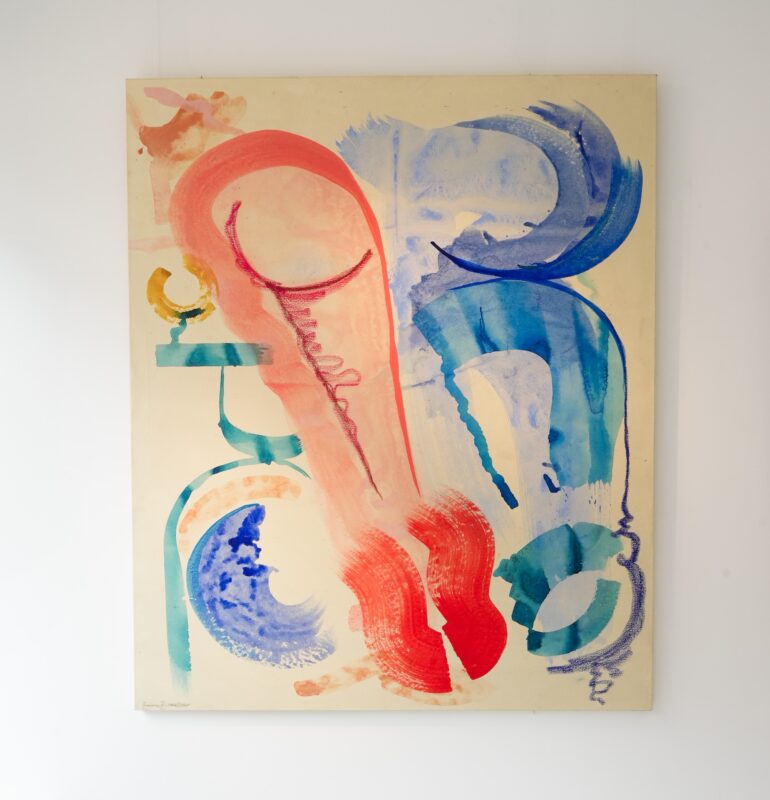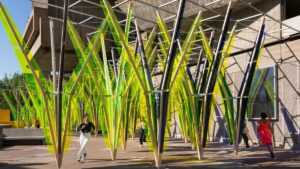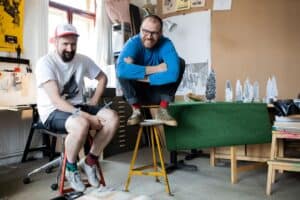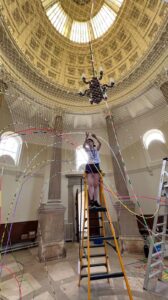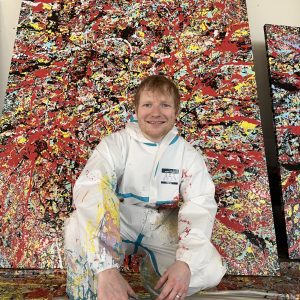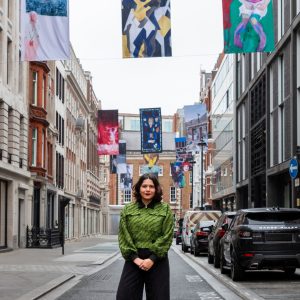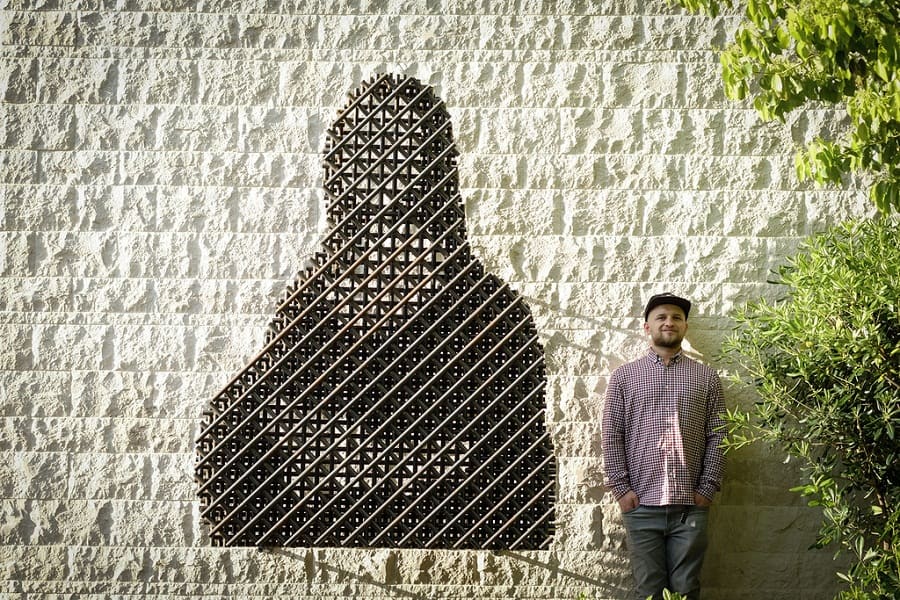
We managed to catch up with the artist Kostya Benkovich who is one of the twelve artists taking part in the KCAW Public Art Trail.
Could you tell us briefly about your artistic practice?
In my works, I frequently use popular symbols of pop culture. I take an instantly recognizable image and deconstruct it through the choice of medium, colour, scale, and modular construction, which completely alter its context. These reconceptualised images would take on completely new critical, political, and desacralized overtones. Freedom and its lack/absence are the major recurring issues in my work. As my medium I use steel rebar aided by welding and forging techniques. In Russia, steel rebar is a coded medium, strongly associated with the lack of freedom. Various kinds of bars accompany Russians from birth to death: one can spot them in numerous fences, gates, windows, prisons, and even in cemetery fences. Steel reinforcement bars are an indisputable symbol of aggression.
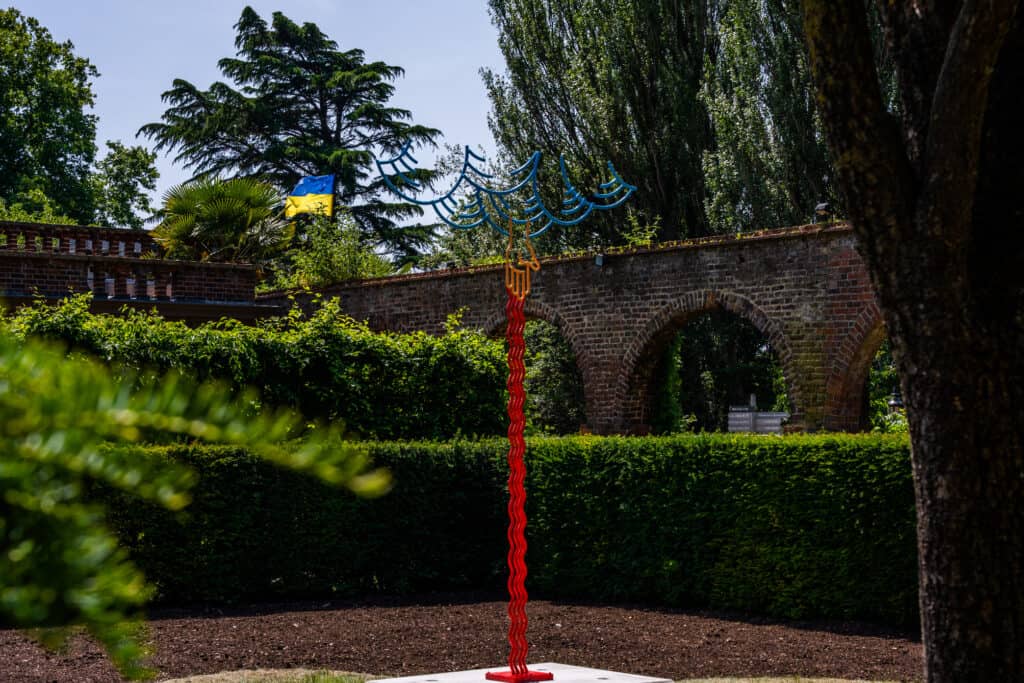
Is sculpture your primary media or do you work in multiple media?
Yes, you may say that sculpture is my primary medium. I do not perceive myself as a classical sculptor, though, since my work is predominantly flat and reliant on a graphic method. I mean that my works are a symbiosis of graphics and sculpture. I would define my approach as linearity in space. I studied at the St Petersburg Stieglitz Academy of Art and Design, at the Department of Decorative and Monumental Art, and specialised in Architectural Metalwork. I attempt to make the most of my skills while working on a project. However, if I see that a different medium can be better suited to the intended message of my artwork, I am happy to use acrylic paints and spray cans on canvas, apply watercolours on paper, or just switch to the digital format. The idea is always of paramount importance, no doubt. However, the artwork only wins, if the concept is matched up by the high quality of execution. Ai Weiwei’s works, perhaps, embody this principle at its best: they carry a profound meaning while being carefully and skilfully crafted (and I am not afraid of this word).
Yes, I am quite a fan of Ai Weiwei. In 2015, when visiting his exhibition at HAM in Helsinki, I was very much impressed by his installations Rebar and Case (2014) and Garbage Container (2014). The first artwork referenced the Sichuan Earthquake and strongly resembled child-sized coffins, thus commemorating the children who had perished in an earthquake because their school’s steel reinforcement bars were not strong enough to withstand the terrible earthquake (apparently, they were of a much inferior quality than required). Steel reinforcement bars should be made of a very strong material that is not supposed to break or bend. If this happens, then the world is falling apart, both literally and metaphorically. The second installation, Garbage Container (2014), was modelled after a garbage container and was intended as a tragic commentary on rural poverty in China and neglected homeless children who sought shelter inside a garbage container, only to die of carbon monoxide poisoning while trying to light a fire in hope to warm up. Each work hit me like a punch in the solar plexus.
What impressed me the most, was how Ai Weiwei married his concept and the quality of execution, the way he combined the relevance of his ideas with traditional artistic methods, characteristic of applied and decorative arts. He used wood, porcelain, steel rebar, plastic, and other materials, and each minute detail carried a certain message. Everything was exactly in the right place, working to enhance the overall impression. Ai Weiwei’s art is extremely well made: the correlation of skill and concept is simply exceptional. This is my ideal. This is exactly the impact, the effect that I am looking to achieve in my work.
Among other important maîtres who influenced my approach, were Jasper Jones, Anish Kapoor, Richard Serra, Dan Colen and Anthony Gormley (I am so grateful that I had an opportunity to visit him at his studio, it was an unforgettable encounter that I greatly treasure!).
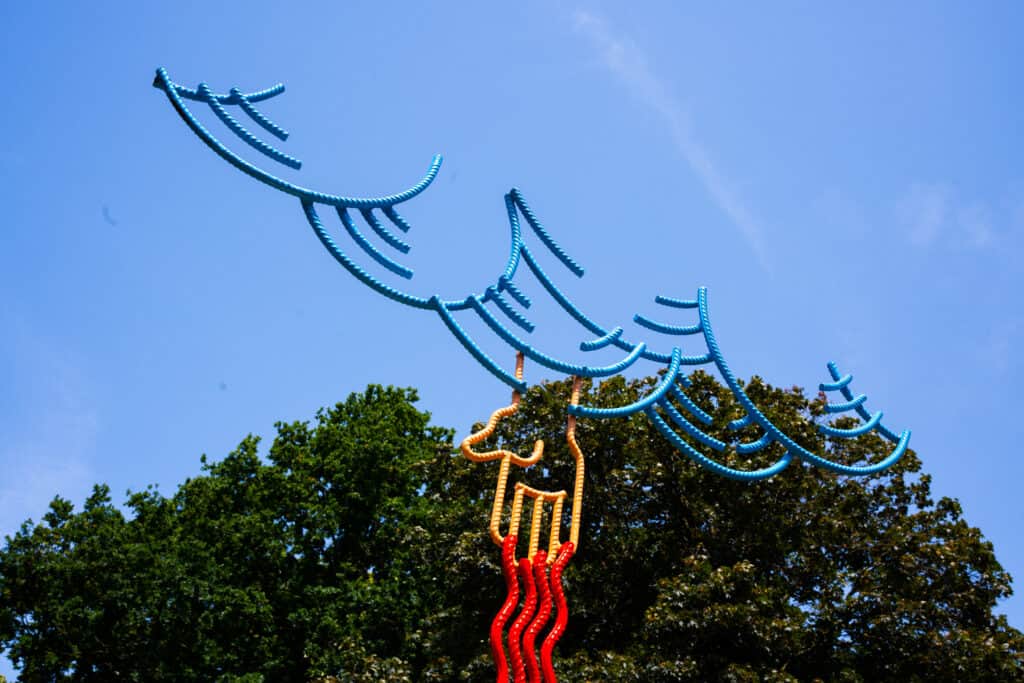
What work are you showing as part of the KCAW Public Art Trail and where is it located?
I participate with my installation The Right Hand of God (and the Gory Deluge) which is showing in the historical Napoleon’s Garden, in Holland Park, Central London. It features the Right Hand of God towering above the rivers of blood. The idea of the artwork occurred to me as I looked at the documentary images, chronicling the most devastating war between Russia and Ukraine. This Hand is the hand of judgment for the perpetrators of evil, and the place of refuge for the innocent people, who suffer the greatest injustice caused by this war.
I often address biblical narratives, seeking to bring them closer to our contemporary situation and provide a relevant interpretation. Visually, the installation deals with the established religious iconography of the Right Hand of God, common both in the Jewish Art of the Late Antiquity and Christian iconography of the late classical and early medieval periods. In the Bible, the Right Hand of God had a sacred meaning and appeared as a sign of God’s presence, a manifestation of the voice of God, and symbol of God’s acceptance of a sacrifice. However, I conflated the symbols of God’s benevolence and protection with His apocalyptic wrath in one single image.
Today, as never before, the humanity stands on the brink of the third world war, threatening nuclear apocalypse and total self-annihilation. I believe that it has become our personal duty to read the warning signs and prevent the approaching catastrophe. And the sculpture is the reminder of that.
It is the second work from the “Divine Interventions” series exploring the idea of God’s interference into human affairs. The first work was completed in Russia in the summer of 2020, at the height of the coronavirus pandemic, when the whole world appeared overwhelmed with panic in the face of the unknown, rapidly spreading deadly virus.
That work was installed on top of a railway collector in Bratsk. The gaping dark space of the collector was simultaneously evocative of a planet and of an abyss. The Right Hand of God in a rubber glove stood as the embodiment of the pandemic and the tribulations it brought about.
How do people learn of your artworks and get updated on your projects?
Like many contemporary artists, I hold personal accounts on Facebook and Instagram, where my fans can follow my posts, find out about my new artworks and learn about upcoming projects. I have also got my own Wikipedia page.
I became known as an activist artist mainly through social media, and this is how my projects and installations went viral. I would normally post photos of my street “interventions” (i.e. my artworks) on social media, and then my followers would share them through their networks. Some of these projects eventually reached millions of people. Most of the opposition media (before they got shut down) would also support my actions.
I took part in a number of large-scale museum projects and collaborated with leading contemporary art galleries and curators. My artworks can also be found in many museums, private and corporate collections across the globe. Speaking of the UK, in 2017-2018, my works were exhibited at the Saatchi Gallery in the critically acclaimed show “Art Riot: Post-Soviet Actionism“. However, this is the first time I have participated in a London art festival and this outdoors installation is my UK debut.
What are your plans for the rest of 2022?
Well, I have some projects in tow. In the autumn and winter of 2021, I was busy working on a large-scale project dedicated to American hip-hop stars who passed away too young too soon. This project was supported and encouraged by the Bird & Carrot art residence initiative.
Many people heard of the 27 Club, but I am exploring a recent new phenomenon, which I provisionally refer to as “20:21”. It concerns lyrical heroes, who have become outcasts and rebels, rapped their emotionally charged poetry, confided love dramas to their listeners and shared their views on socially significant events, thus, becoming the voice of a whole generation. In this project, I comment on the impact of social networks, discuss how big fashion brands influence teenagers and briefly deal with the causes that led to the emergence of the BLM movement. The launch of this project in London is tba early this autumn, so don’t miss out.
Also, we are negotiating with Bird & Carrot on the production of the next work in the “Divine Interventions” series. The sculpture will be called Stairway to Heaven. Like Jacob’s ladder in the Book of Genesis (Gen. 28:10-22), this stairway connects Heaven and Earth and symbolises the hope that the impending catastrophe will be prevented, and humanity will recover from the trials of the recent years.
I am also planning to take part in the Carte Blanche festival, scheduled to happen in Tel-Aviv this summer. This is a street art festival, so I will have an opportunity to try my hand at producing outdoor graphic works and medium-sized murals.
Also, together with Bird & Carrot, we are planning an installation commemorating the plight of refugees across the world. It is called “Suitcase” and features a solitary abandoned suitcase made of steel rebar, the symbol of displacement and homelessness, and the embodiment of the previous life that has been destroyed by the war. According to the UN refugee agency, UNHCR, 100 million people are now forcibly displaced worldwide.
The Right Hand of God, Konstantin Benkovich Napoleon Garden, Holland Park, Kensington, London W8 6LU, UK – 30th August 2022
The project runs as part of the Bird & Carrot art residency initiative. With special thank you to Catherine Loewe, our Art Trail Committee 2022.
